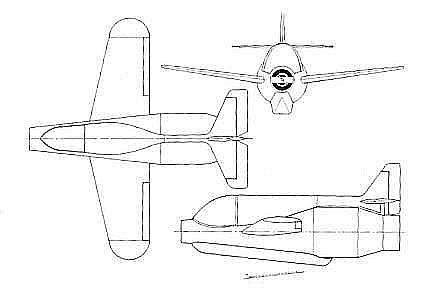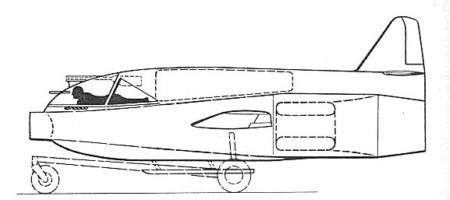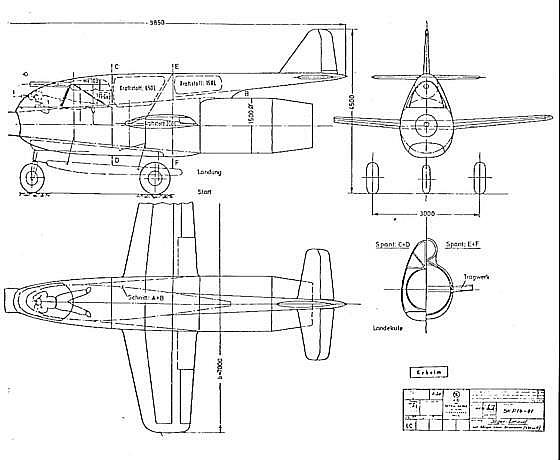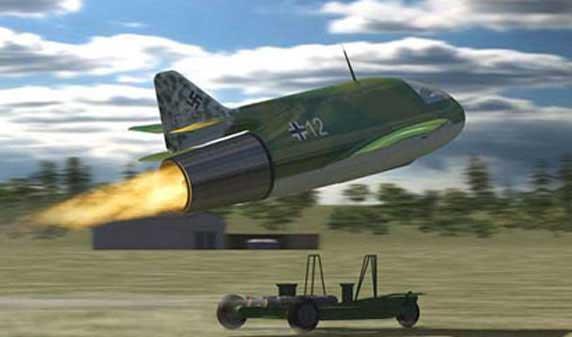The radical SK P14 fighter was designed around a Sänger ramjet and was to have taken off on a three-wheel bogie. Development was abandoned in 1944 with the termination of Sänger's ramjet research programme
Work on the P.14 started in the beginning of 1945,designed with the aid of Eugen Sanger, the aircraft was built around a Sanger Ramjet. The ramjet formed a large part of the fuselage with it's combustion chamber and exhaust nozzle being exposed to aid cooling. Take off was with booster rockets fitted to a detachable launch trolley to bring the P.14 to a speed were the Ramjet would work around 200 mph. Construction of parts for the P.14 had begun by the end of WWII.
| Type |
|
| Engine |
1 Sanger Designed Lorin Ramjet |
| Dimensions |
Length , height , span 7,90 m , wing area , |
| Weights |
Empty , loaded , max. take off weight |
| Performance |
Max.. speed , cruising speed , range , endurance , service ceiling , climb |




It was perhaps- fitting that Kauba's last project should be his most spectacular-the SK P14 ramjet-driven interceptor.
The SK P14 fighter was designed around a 31 ft 2 in (9,5 m) ramjet developed by Eugen Saenger and intended to operate on diesel oil or powdered coal! Saenger had been working on ramjets for a number of years and in 1944, with some RLM support, Kauba began to evince interest in the possible application of this revolutionary power plant as the prime mover of a fighter. The sheer size of the ramjet rendered its installation in a small fighter difficult, and Kauba elected to build the power plant as an integral part of the aircraft, housing the pilot, armament and all fuel in a superstructure built above the ramjet. The pilot lay prone above the narrow neck of the ramjet, a single 30-mm MK 103 cannon being mounted above the pilot with a single large fuel tank of 297 Imp gal (1 3501) capacity immediately aft and conforming
in shape to the contour of the diffuser portion of the power plant. The intake was carried forward slightly beyond the nose, and the diffuser gradually tapered to the parallel-sided combustion chamber which possessed a diameter of 4 ft 1 I in (1,5 m), conventional wings spanning 25 ft I lin. (7,9 m) and having an area of 134 sq ft (12,5 m') were fitted, and the diminutive tail surfaces were also conventional. For take-off it was intended that a three-wheel bogie would be used, this being jettisoned as soon as the SK P14 was airborne and the landing being effected on an extensible skid.
It was estimated that the Sänger ramjet would provide 9,680 Ib thrust (4 390 kgp) at sea level at 630 mph (1010 km/h) and 2,970 Ib thrust (l 350 kgp) at 33,000 ft (10 060 m) at- 545 mph (880 km/h), loaded weight being 6,270-6,820 Ib (2 845-3 090 kg). Estimated performance included the ability to reach a service ceiling of 59,880 ft (18 250 m), initial climb rate being 26,500 ft/min (134,6 m/sec) and altitudes of 19,685 ft (6000m) and 32,810 ft (10 000 m) being attained in 1.7 and 6.3 min respectively. Maximum endurance was expected to range from 28 min at 230 mph (370 km/h) at sea level to 43 min at 355 mph (570 km/h) at 32,810 ft (10000 m).



